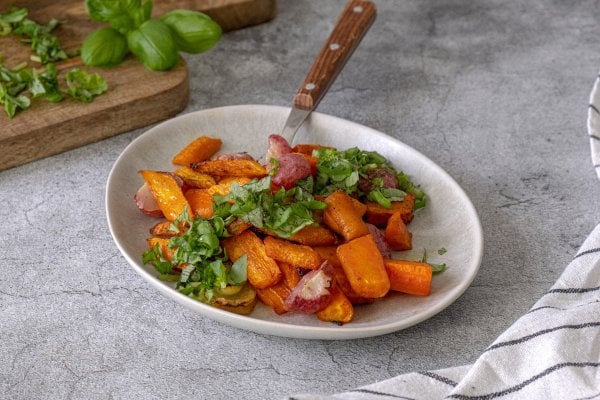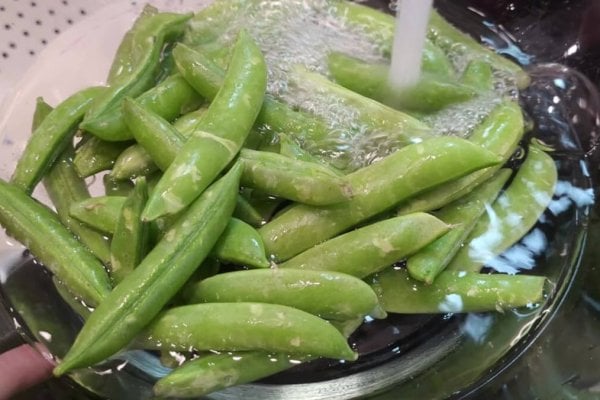One of the questions I get asked often is how much it costs to run an average batch in the freeze dryer. Though this number will vary based on your unique situation, I was able to find some averages, and I’m breaking them all down in this post.

Why I Love the Freeze Dryer
You all know my love for my freeze dryer, but it’s important to know that I was probably one of the biggest skeptics before I had one! You can read my one-year review of our Harvest Right Freeze Dryer here.
Though our first freeze dryer was given to us by Harvest Right for our honest review, it should be noted that we have since purchased two more because they’ve revolutionized our homestead preservation so much!
If you’re looking to learn more about freeze dryers, I recommend checking out my posts on the top freeze dryer FAQs, what freeze dryer is right for you, our favorite must-have freeze drying supplies, what foods cannot be freeze dried and how to use oxygen absorbers.

How Freeze Drying Saves Money
As I said, I avoided getting a freeze dryer for years because I simply didn’t think they were necessary for homestead preservation. Boy, was I humbled once I realized what an asset this machine has become to our preservation season!
Though I know they can still be cost-prohibitive for many, here are some of the reasons why I recommend considering adding one to your arsenal of preservation methods:
- Easy & Fast – Though, on average, the freeze dryer runs for 24-48 hours, there is very little hands-on time for this preservation method. Once you’ve cleaned and chopped your food, it simply goes on the tray, and you “set it and forget it” until it’s ready to package up.
- Buy in Season – When you have a way to preserve large quantities of food at once, it allows you to buy produce in season from local farmers or farmer’s markets. This means you’re preserving your food at the peak of freshness and will enjoy that great flavor all year long.
- Save on Bulk – When you’re buying in season, this also means you can typically buy in bulk and save big on produce! Many of our local farm stands offer big boxes of produce at a largely discounted rate. Having a way to preserve all that food at once means it’s not going to waste.
- Side Hustle – I know many people who have turned their freeze dryer into a side hustle business selling freeze dried berries, freeze dried candy and more! When your machine pays for itself, I call that a win-win.

How Much Does it Cost to Run a Freeze Dryer?
OK, now it’s time to get down to the nitty-gritty of the average cost to run a batch of food through the freeze dryer. First, we need to discuss electricity costs.
Average Electricity Costs
At the time of this posting, the cost of electricity in the United States varies from 9¢ per kilowatt hour all the way up to 45¢ per kilowatt hour. Those kilowatt hours add up quickly so this can be a big difference in cost.
Cost Comparison for Multiple Forms of Food Preservation
As I mentioned, many freeze drying batches only take about 24 hours, but some can take up to 48 hours. This is a big difference. For the sake of finding the “average” cost to run a freeze dryer, I wanted to be sure I erred on the side of the most it would cost, so the chart below is for a 40-hour run time.
The following chart takes into account all the averages we could find and compares the cost across multiple forms of food preservation:

Tips for a Short Freeze Dryer Run Time
There are some tricks I use to make sure I’m preserving my food for as little cost to me as possible:
- Cool Location – It’s best to operate your freeze dryer in a climate-controlled or cool location. This means the machine doesn’t have to work as hard to freeze dry your food. I recommend putting your freeze dryer in an air-conditioned room or using fans to blow air toward your freeze dryer. Also, make sure your machine is pulled away from walls for better air circulation.
- Pre-Freeze Food – I always pre-freeze my food for at least 48 hours prior to placing it in the freeze dryer. This means the machine doesn’t have to work as hard to get the food to the proper temperature before starting the freeze drying process. These tray stackers are great and really help reduce the space needed for pre-freezing food.
- Extra Dry Time – Try to avoid letting your machine run the extra dry time once a batch of food finishes. Try to get to the machine right as your food finishes and check it to make sure it’s done. As soon as it’s ready, turn the machine off and save that extra energy!
Now that you know how much it will cost to freeze dry a batch of food, head on over to this post and learn which freeze dryer is right for you!

Becoming a Freeze Drying Master
Did you know that when it comes to freeze drying, every food is unique and can have minor differences that either make or break your success?
In my book Freeze Drying the Harvest: Preserving Food the Modern Way
I’ve included specific, detailed guidance on how to freeze dry all your foods properly.
I’ve covered all the things I wish I knew when I first started freeze drying, like…
- Why you should be freeze drying
- How to choose the right freeze dryer
- How to set up your freeze dryer
- How much it actually costs to run a freeze dryer
- How to maintain your freeze dryer
- What other equipment you really need (or don’t)
- Which foods you can freeze dry
- Which foods you cannot freeze dry
- Food safety with freeze drying
- How to rehydrate your freeze dried foods
Is learning easier when you have video visuals to guide you through the process step-by-step? Then, my Freeze Drying Masterclass has you covered!
These resources can be purchased separately or as companions, so whether you choose the book or the masterclass, you will receive all the information I wished I had when I first began my freeze drying journey.



















